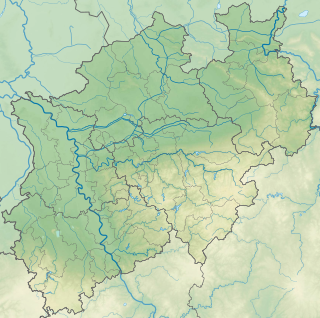Eastern Wupperengal
| Eastern Wupperengal | |||
|---|---|---|---|
| Wupper between Oedeschlenke and Neuland | |||
| Systematics according to | Handbook of the natural spatial structure of Germany | ||
| Greater region 1st order | Low mountain range threshold | ||
| Greater region 2nd order | Rhenish Slate Mountains | ||
| Main unit group | 33 → Süderbergland |
||
| About main unit | 338 → Bergische plateaus |
||
| 4th order region (main unit) |
338.1 → Bergisch-Märkische plateaus |
||
| Natural space |
338.11 → Eastern Wupperengal |
||
| Geographical location | |||
| Coordinates | 51 ° 15 ′ 0 ″ N , 7 ° 18 ′ 14 ″ E | ||
|
|||
| local community | Hückeswagen , Radevormwald , Remscheid , Wuppertal , Ennepetal , Schwelm | ||
| state | North Rhine-Westphalia | ||
| Country | Germany | ||
The eastern Wupperengal is a natural spatial unit with the number 338.11 and belongs to the higher-level natural area 338.1 ( Bergisch-Märkische plateau ).
According to the handbook of the natural spatial structure of Germany, the eastern Wuppereng valley comprises the narrow valley of the Wupper between Hückeswagen at an altitude of 250 m and Wuppertal - Oberbarmen at an altitude of 170 m. The river, which runs in a south-north direction, causes a slope across the mountains of the Southern Uplands, which stretches from west-south-west to east-north-east .
The slopes to the river are steep, shallow and forested throughout. In the southern area between Hückeswagen and Krebsöge , the Wupper was dammed up to form the Wuppertalsperre , followed by the Radevormwald Wupper villages with their long history of textile industry.
From here, a continuous valley road and the disused Wuppertal Railway follow the course of the river, which has two further impoundments within the natural area with the Dahlhausen reservoir and the Beyenburger reservoir . Between Wuppertal- Beyenburg and Oberbarmen the buildings and large factories for the paper, textile and chemical industries ( Erfurt and Sohn , Vorwerk , JP Bemberg / Enka Glanzstoff AG ) dominate the valley floor.
Places in the natural area (following the course of the river)
- Beak mill
- Kräwinkler Bridge
- Crab bugs
- Wilhelmstal
- Dahlhausen
- Bird mill
- Dahlerau
- Oedeschenke
- Beyenburg
- Dahlhausen
- Kemna
- Laaken
- Öhde
- Rauental
- Heckinghausen
- Oberbarmen ( Rittershausen )

